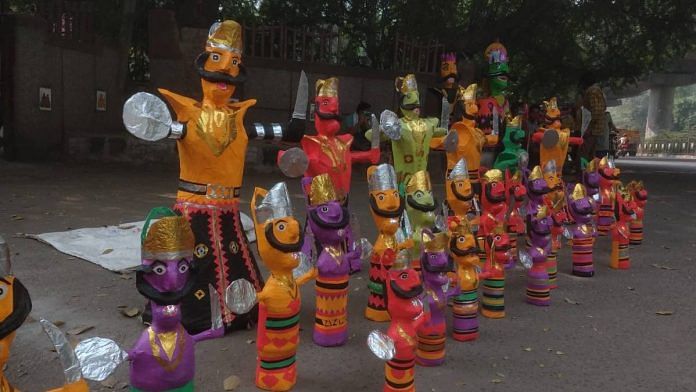
New Delhi: If it was any other year, Tatarpur village in west Delhi — Asia’s largest Ravana effigy market — would have been buzzing with shoppers by this time. But like everything else in 2020, the Covid-19 pandemic has disrupted and dampened the festive spirit around Dussehra celebrations.
Any other year would have seen Delhi’s streets dotted with effigies in varying sizes being burned on Dusshera. The pandemic, however, cut sales to less than 20%.
The market lay uncharacteristically desolate and devoid of bustling crowds in the days leading up to Sunday, the 10th day of the Navaratri festival. Multiple avatars of the mythical characters Ravan, Kumbhkaran and Meghnadh have been missing from the displays in the market.
“The footpaths are usually full of effigies right from Subhash Nagar batti (traffic light) to Rajouri Garden Metro station, but this time, there are hardly any vendors beyond Tatarpur,” Anand told ThePrint. Anand has been selling effigies for around seven years now.
Bobby, who owns the store Shankar Ravan Waale in the locality, explained how Tatarpur village became a hub for the effigy business.
“An old man, popularly known as Ravan Waale Baba, started the tradition of making effigies, and soon the entire community joined in. Ravana-making is a seasonal khaandaani (family) business for most of us here.”
However, this year business is at a near stand-still, with barely any sales.
“There are around 35 families involved in the Ravana-making business here. This time about 22-23 of them haven’t even made any,” Bobby said.
Fewer orders, smaller Ravans, higher costs
Dusshera usually brings with it memories of giant, 30-40 feet tall effigies erupting into flames. However, this year, the hottest selling product has been Ravan effigies of upto 5 feet. Every stall set up in the market has a selection of these miniature effigies, selling mostly to families and loyal customers.
The Delhi Disaster Management Authority denied permission for organising or conducting melas, jhoolas and exhibitions till 31 October. This automatically ruled out the usual large gatherings and Dussehra melas where huge effigies would be burned down.
The domino effect has resulted in major losses for effigy makers whose seasonal trade is the only source of income. Many of these khaandaani businesses have been in the trade for the past 60-70 years.
Of the few tall orders received this season, none have been for effigies taller than 35 feet, a relative dwarf size compared to the 100-foot effigies ordered in the previous years.
The average height requested this year has been about 15 feet to 20 feet, mostly from malls, farmhouses, hotels and several residential societies in the National Capital Region.
“Previously, we used to make about 25-30 Ravanas that were taller than 35 feet, but in the absence of Ram Leelas and Dussehra melas, we haven’t made any,” Mamta Sarsir of New India Raavan Wale told ThePrint.
Their total sales this year are a sad reminder of what a good time for business the festival typically is. “We usually manage to sell 50-60 effigies by this time, but have sold only about 22 this year. We’re at a loss of about Rs 1.5 lakh because of Covid-19,” Sarsir said.
She added that the hit isn’t just to the domestic market; the company would also export to countries such as Australia and Canada. This year they have had zero international order.
Vendors say this year’s business has shrunk to about 15-20 per cent of previous years’ sales. Sarsir estimates that the Tatarpur market has suffered a collective loss of Rs 20 lakh to Rs 25 lakh.
To make matters worse, the cost of materials used to make effigies went up. “Materials such as bamboo, stokin wire, khaki paper and gum have nearly doubled this year,” Sarsir said.
Not just materials, but cost of labour also shot up since many of the workers haven’t returned from their villages since the lockdown was imposed. Bobby said he tried to arrange for their travel, accommodation and food — expenses businesses like his didn’t have to incur earlier since artisans stayed in Delhi itself.
This has resulted in the effigies itself becoming more expensive.
“Last year we sold effigies at 500 per foot, now we’re selling them at Rs 600 per foot,” Bobby said.
Subscribe to our channels on YouTube & Telegram
Why news media is in crisis & How you can fix it
India needs free, fair, non-hyphenated and questioning journalism even more as it faces multiple crises.
But the news media is in a crisis of its own. There have been brutal layoffs and pay-cuts. The best of journalism is shrinking, yielding to crude prime-time spectacle.
ThePrint has the finest young reporters, columnists and editors working for it. Sustaining journalism of this quality needs smart and thinking people like you to pay for it. Whether you live in India or overseas, you can do it here.